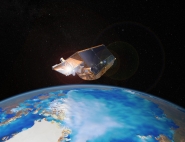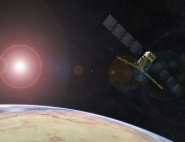Ground Segment
The SMOS System, with its major components, is illustrated by the SMOS System architecture diagram depicted in the following picture:
![]()
SOGS
The Spacecraft Operations Ground Segment (SOGS), located at CNES Toulouse (France), will be responsible for spacecraft S-Band telemetry. The SOGS will collect and archive the spacecraft health and status data; it will ensure spacecraft command and validation as well as relay (uplink) of payload commands.
SOGS communication will be used to ensure command and data transfer. The S-band telemetry system will be used for both spacecraft and payload commanding, for downlink of spacecraft and critical payload health and status data. The S-Band telemetry system will also be responsible for receiving the payload telemetry and transfer it to the PLPC. Lastly, it will be in charge of payload programming by transmitting to the spacecraft the payload commands generated by the PLPC. The SOGS will use the S-Band stations of Kiruna (Sweden) and Aussaguel (France).
![]()
PLPC
The PayLoad operations Programming Centre (PLPC) is in charge of monitoring, controlling and programming the operations of the SMOS instrument.
Located in Villafranca, the PLPC will ensure the interfaces and links between the mission centre (DPGS in Villafranca) and the satellite control centre (SOGS in Toulouse). Specifically, the PLPC will:
- acquire and monitor, from the SOGS, all SMOS instrument housekeeping telemetry routed from the satellite to the ground via the S-Band telemetry channel;
- receive the high-level Payload Operations Plan (POP) generated by the SMOS mission centre, convert it into validated groups/sequences of instrument commands and transmit them to the SOGS for uplinking to the satellite.
DPGS
ESA/CDTI Level 1 and 2 Data Processing Ground Segment (DPGS) bi-located at the ESA-VILSPA facility in Villafranca and the ESRIN facility in Frascati. The DPGS, in charge of acquiring, processing, archiving, and dispatching the SMOS scientific data, is mainly composed of: an X-Band Acquisition Station, a Payload Data Processing Centre whose main function is to process, calibrate and archive the SMOS scientific data up to level 2 and a SMOS User Service centre insuring enterfaces and services between the SMOS System and the external users.
CATDS
CNES's Centre Aval de Traitement des Données SMOS (CATDS) is in charge of SMOS scientific data at levels 3 and 4. The CATDS will process, calibrate, archive and dispatch the SMOS scientific data at levels 3 and 4 derived from the level 1 and 2 products. The CATDS architecture is based on two main types of components:
- two Expertise Centres (OS and SM) which will host the development, validation and improvement of the L3 and L4 algorithms in close co-operation with the scientific community, which will assess the quality of the products and will provide specific information to users.
- one single Processing Data Centre (PDC), which will routinely produce and disseminate L3 and L4 data from auxiliary data and from L1B, which is the last product level not separated on the basis of land or sea, provided by the DPGS. The option considered is to not decorrelate the processing of the two kinds of products: the CATDS will produce simultaneously OS and SM products. L3 and L4 products will be produced and disseminated once a day. They are based on the last 10 days of L1B. The PDC will also manage product catalogue and archive.
The CATDS will also probably help to fine tune the calibration for SMOS algorithms, improve and validate algorithms from L0 to L2 processing. Once validated, these algorithms will be proposed for a transfer to the DPGS.


